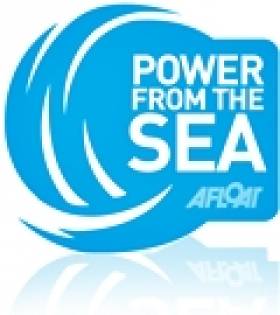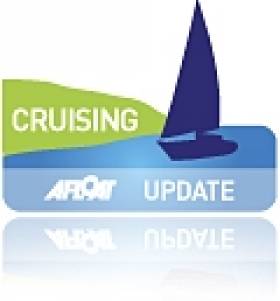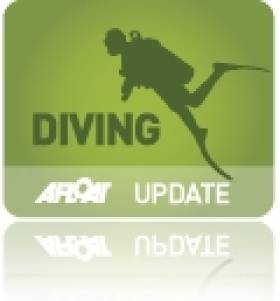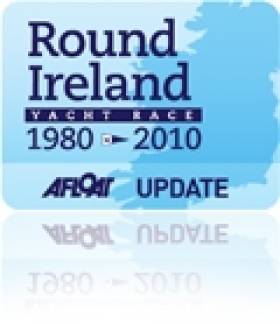Displaying items by tag: Arklow
#POWER FROM THE SEA - This morning the wind farm turbine installation vessel Sea Energy, departed Wicklow Bay having spent over a fortnight based in Wicklow Port, where her Danish crew celebrated Christmas Day, writes Jehan Ashmore.
The Esbjerg registered vessel operated by A2 Sea, arrived in the week before Christmas to work at Airtricity's Arklow Bank Wind Farm, but the nature of the work was based on internal operations only at the seven turbine facility, which each structure scaling to a height of over 70 metres / 240 feet.
Upon completion of her work, she returned to Wicklow where her crew spent the festive season in port with a Christmas tree complete with lights! at the bow.
She remained in the harbour into the New Year and during the recent spate of heavy weather until finally departing yesterday on Little Christmas, where she overnighted in the bay.
With four towering supporting jack-up legs each 32 metres high, this enables her to carry out offshore crane operations with greater control. In addition the vessel is raised completely above the water to gain elevation to assist mounting the pre-assembled wind-turbine components from her deck cargo.
She can work in waters of up to 24 metres and as she rests on the sea-bed this provides a more stable working platform.
Sea Energy presented a distinctive profile while in port as she 'sat' close to the Packet Quay, as her jack-up legs make mooring ropes redundant.
The quay is the main commercial quay and during this week she vacated the berth to allow regular caller Scot Isles (2001/2,595grt) which arrived with a cargo of sawn packaged timber products from Scandinavia. Owned by Scot Line, the vessel remained in the port for two days and then departed for Warrenpoint.
The Wicklow Port Company also specialise in dry-cargoes, lead, and scrap-metal as previously reported, to read more click HERE.
It is somewhat unusual for vessel movements in Wicklow to berth outside the harbour piers, as in the case with Sea Energy.
She shifted berths to the seaward side of the West Pier and again she sat with jack-legs lowered in water depths of six metres, leaving a clearance of around two metres below the keel.
Although Arklow is closer to the wind-farm than Wicklow, Sea Energy's 3,332 gross tonnes is too large to be accommodated as the port on the River Avoca has a has lower water depth.
Forty Boats Prepare for Liffey Cruise
The boats are mostly modest sailing yachts with some motor cruisers, typically eight to twelve metres long with up to six people aboard. They come from ports on the East coast of Ireland between Arklow and Skerries.
The sailors will spend the afternoon visiting other boats, renewing friendships and comparing notes. Some will use the opportunity to explore the city centre from this unusual perspective.
There are organised visits to the Jeanie Johnston and the Guinness Storehouse. A special attraction this year is a guided tour of the docks in an inflatable boat, by Sea Safari.
In the evening the whole group, about a hundred people, will gather for dinner in a nearby hotel. Formalities will be limited to a review of the season in general and the summer cruise in Strangford Lough, but the party is likely to continue until late.
Most sailors will spend the night aboard their boats. On Sunday morning commodore Derek Harris will say mass aboard the Jeanie Johnston. The bridges will open once more at noon, and the fleet will disperse to their home ports.
This annual event is organised by the Cruising Association of Ireland with the co-operation of the Dublin Docklands Development Authority and Dublin Corporation.
The Cruising Association of Ireland supports and represents the cruising community in Ireland, both power and sail (www.cruising.ie). Contact Derek Harris 087 6740334 [email protected], or Simon Parker 0872497859 [email protected]
ISORA Fleet Prepares for Arklow Race
After the pasting the ISORA fleet got last weekend in the first ISORA offshore race of the season the good news is that conditions on the Irish Sea look better with moderate south east winds promised for Saturday.
The next race in the series, from Dun Laoghaire to Arklow and back, will be run at 0955 in conjunction with the Lee Overlay/Royal Alfred Yacht Club 2011 Offshore Series race using the same start, course and finish.
The start line will be located in Scotsman's Bay in the vicinity of DBSC's 'Pier' mark.
The fleet will leave the Muglins to starboard, Arklow North to Port and on the way back to Dun Laoghaire then Muglins to port.
Eleven Races in Busy Irish Sea Offshore Schedule
Chairman of ISORA Peter Ryan sets out the 2011 programme for ISORA that kicks off on April 7th with an introductory evening on April 7th.
Spring has come and the days are getting longer. It is now time to be thinking about offshore racing again. The first race is on the 30th April from Dun Laoghaire to Holyhead.
I attach again the latest Race Schedule, Notice of Race, Conditions and Entry Form for 2011. I also attach details of the proposed "Offshore Introduction" night for offshore racing on the 7th April. Even if you are experienced, you can add to the proceedings or just come for the reception after.
There is an extensive list of eleven races in the schedule. The types of race vary greatly to give a variety of racing experiences. There are Day Races, Night Races, Short Cross Channel Races, Medium Cross Channel Races, 100 mile Lyver Trophy Race and "The Dingle Skellig Hotel D2D" – Dingle Race. There is racing for IRC, IRC No Spinnaker and 2-handed classes.
This season, if the number of entries permits, we will be running a Classic Class in both Class 1 & 2. The boats eligible for the Classic Classes will be selected by the Sailing Committee before the start of the first race and the selection will be based on the boats performance / capability during the previous season. It is hoped that this will provide a much greater spread of prizes. The rating break for Class 1 and Class 2 will be decided at the same time.
The Race schedule has been carefully selected to ensure the maximum amount of sailing and social life is obtained. The usual "get together" will take place before and after each race. This season we have some additional attractions:
If desired, the race on the 28th May from Pwllheli to Wicklow can be followed by boats taking part in the "Turbine Race" (see www.arklowsc.com on Sunday 29th. This race starts and finishes in Arklow, 10 miles from Wicklow. This will allow the usual "get together" in Wicklow on Saturday evening and another one in Arklow on Sunday after the Turbine Race. This is the UK Bank Holiday weekend and will allow the UK boats time to return home on Monday!
After taking part in the "Dingle Skellig Hotel D2D Dingle Race" on the 11th June. Please note that a second separate entry to the NYC is required if taking part in this race in the series. After a few relaxing nights in Dingle, you can wander around to take part in the "ICRA Championships" in Crosshaven before making your way to Kinsale for the "Sovereign's Cup". The Dingle Race is a qulaifier race for the Fastnet Race.
The Lyver Race on the 1st July is a Feeder Race to the Volvo Dun Laoghaire Regatta from the 7th-10th July – a great few days sailing in Dublin Bay. This race is a RORC qualifier for the Fastnet Race. Again, seperate entry is required for the Liverpool Yacht Club sections of the event.
The Sunday Race on the 14th August will take place directly after the start of the Solitaire du Figaro fleet from Dun Laoghaire. If possible we will set a course to follow the fleet down the coast. For visiting boats to Dun Laoghaire, the Figaro fleet will arrive in Dun Laoghaire on the Wednesday 10th August and there will be a festival in Dun Laoghaire for the couple of days to celebrate the event. There will be great craic in Dun Laoghaire for those days.
You may not have noticed but the ISORA website www.isora.org has been upgraded and will become very active this year. There is a "Crew Register" and a "Buy and Sell" section in the "Forum" page. I would encourage everyone to register for this facility and use it to get crew for races or for crew to get boats. Try the website out.
The "ISORA Introductory Evening" in the NYC on the 7th April. The purpose of this is to encourage those boats who are thinking of taking part in Offshore Racing by a series of talks about what is involved in this type of racing. I will also use this session to demonstrate the use of the new website's "Crew Register". I also hope to issue detailed instructions by email on the use of this facility. The session will be followed by a reception where people can solialise and relax. "Prof" O'Connell and Mick Liddy will be talking at the event. I will also be encouraging participation from the audience. It will be a great night so please come and bring a friend.
I look forward to receiving your entries very soon. I would appreciate it if you could also spread the good news about ISORA and Offshore Racing.
Diving Asgard II
In September 2008 an iconic part of maritime Ireland silently and tacitly slipped beneath the surface of the Bay of Biscay near the idyllic island of Belle Isle writes Timmy Carey.
Asgard II was on a journey from Falmouth to La Rochelle for routine maintenance when it would succumb to its fate of a watery grave, thankfully captain Colm Newport was able to safely abandon the ship with the entire crew of 25.
Since 1981 Asgard II a beautiful brigantine designed by Jack Tyrell and built in Arklow had served the Irish nation with distinction all over the globe, providing sail training for over 10,000 people; the image of the bright green hull and white sails becoming synonymous with Irish sailing.
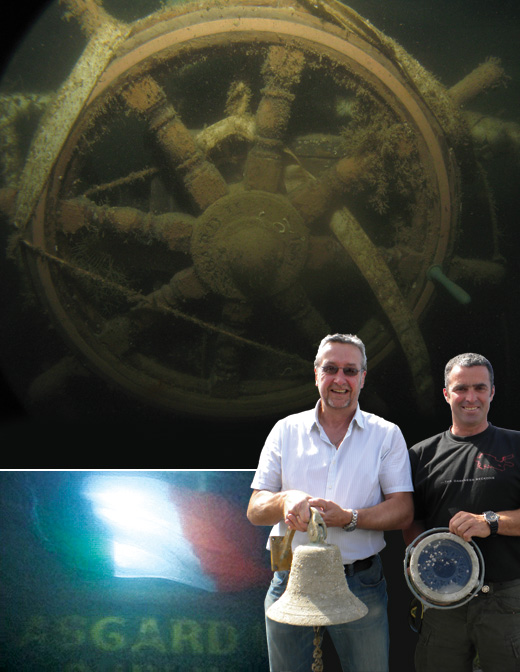
Main: Asgard's wheel prior to removal. Asgard campaigner Captain Gerry Burns (left) holds Asgard's bell with diver Eoin McGarry and the Tricolour defiantly draped on Asgard II
In addition to such a proud history, Asgard II also carried on the name and traditions of Asgard; which played such a pivotal role in Irish history and in the foundation of the state. In Norse religion Asgard was the home of the Norse gods and it is fitting that a vessel with such an auspicious name would later be called "the harbinger of Irish freedom" by the President of Ireland Eamonn De Valera.
Asgard was built in 1905 in larvik and was a wedding gift from Dr and Mrs Hamilton Osgood of Boston to their daughter Mary and her husband Erskine Childers (the father of the future president of Ireland). In a magnificent feat of seamanship (which was reminiscent of his famous novel the riddle of the sands) Erskine Childers in the company of his wife and others expertly collected arms from Hamburg and landed them in Howth on the 26th of July 1914 for the Irish volunteers. In one of the great ironies of Anglo-Irish history Erskine Childers a decorated British war veteran would become an avowed Irish republican and would play a crucial role in the struggle for independence as minister for propaganda (being very highly thought of by both Eamonn De Valera and Michael Collins); before being executed in the Irish civil war.
In 1961 the Irish government purchased the vessel for sail training and in 1968 Coiste and Asgard was founded and was assigned responsibility for the vessel. With the launch of Asgard II, the original Asgard was transferred to the national museum where it has been expertly restored to its original glory and will in the future be available for general viewing.
With such a rich maritime heritage and being so deeply engrossed in Irish history popular view in late 2008 was that the Irish government would salvage Asgard II as a symbol of Irish pride; alas it would later be decided by the Irish government to abandon Asgard II with the uniquely Irish bowsprit of Grainne Uaile condemned to a permanent watery grave on foreign shores.
As with many diving expeditions, they often begin with a simple conversation and one late night a phone call from Eoin McGarry would begin with "what do you think of diving the Asgard II next year". Soon the idea generated its own momentum and a small team of Irish trimix divers (all of whom are CFT members) was assembled and preliminary plans were made for July 2010.
Despite the fact that no permission was necessary to dive the vessel under Irish or French law, it was decided to notify the Irish government of dive teams intentions to video the wreck and recover some of the artefacts for the Irish people. On contacting Coiste an Asgard the reaction of the board was very negative indicating that the artefacts were of little value and that due to the depth involved they were not in favour of any dives taking place.
A little disillusioned it was decided to make representations directly to the Minister for Defence and soon a government TD with a real interest in Irish history discussed the idea with the Minister for Defence Willie O Dea.
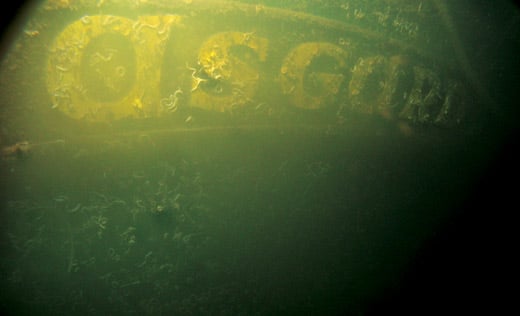
The ships name looming out from the darkness
In early February the dive team would receive a personal letter from the minister indicating that "enquiries are being made into the matter and I will write to you again shortly". In addition a TD had also confirmed to the dive team that the minister had indicated that he thought it was a great idea and wished the dive team well. Unfortunately within a very short time period the minister had to resign and the dive team received no further correspondence.
With the Irish government engrossed in an economic recession of epic proportions, the dive team decided to proceed before the ships artefacts were removed by foreign dive teams and lost to the state forever.
With time ticking by the final team of Eoin Mc Garry as expedition organiser, Brendan Flanagan of Longford Sub Aqua club, Phil Murphy and Frank McKenna both of Kilkenny Sub Aqua and myself were assembled as the bottom divers. With an emphasis on keeping the costs down as the divers would be financing the trip, the decision would eventually be made to have one cover diver to help the divers kit up and look after all the surface logistics; this would also allow all the dive team travel together in the one vehicle and reduce the travel costs. Being a qualified mixed diver as well as native of Brittany; Stephane Portrait of Blackwater Sub Aqua Club would become an essential member of the dive team without whom the trip could not have been successful.
Over the coming months Stephane and Eoin would work tirelessly on the logistics, which would be vastly more onerous and detailed than an expedition to the Lusitania. As well as the small issues of organising ferries, accommodation, a dive centre and a dive boat; the dive team would also notify in writing the local mayor of Belle Isle, the local tourist office, the local lifeboat and the admiral of the French national lifeboat institution in Paris, the local council and the head admiral of the Atlantic fleet of the French navy of the dive teams intentions.
Our dive boat skipper Yann Quere being the secretary of the French national sailing organisation and a Moniteur 3 with FFESSM (the French equivalent of CFT in CMAS), would be of huge assistance and confirmed to the dive team that there were no restrictions in diving the wreck. In addition the Irish government had not even requested an exclusion order be placed on the site to preserve the Asgard II, meaning it could be legally dived by any dive team at any time.
During the last few weeks endless hours would be spent reviewing the vessels plans, photographs and video clips; trying to decide what obstacles could lay ahead in trying to video and photograph the wreck as well as removing the bell, helm and compass. Eoin would even go so far as contacting Tyrell's to get the specifications of how the wheel was fitted and what size bolts were used to bolt the bell on.
A specialist dive tool bag was then assembled with all anticipated tools colour coded and placed into the bag in the order of their anticipated use; to try and eliminate wasting any precious bottom time. Only a few weeks to go and word came that a French technical dive team also had their eyes set on the Asgard II, would we arrive to late and would all the artefacts have disappeared into the possession of French or British divers; only time would tell.
Being Jury president of the CFT Moniteur 3 test on Inisboffin the day before the trip to France, my preparation time was hardly ideal; getting home after 10 pm on Friday then having to blend several mixes and assemble camera and rebreather equipment; grab a precious five hours sleep and head for the ferry. Seeing familiar faces of friends and dive buddies all thoughts of fatigue soon evaporated in anticipation of a good weeks diving. During the last week Paddy Agnew also joined the group and would assist Stephane on the surface during the course of the week.
Arriving in the idyllic harbour of Belle Isle the sight of the Irish Tricolour flying from the tourist office on our behalf was a good omen. That evening our skipper told us the water would be warm, the sea flat calm and visibility would be at least 10 meters with ambient light at depth; and we headed to bed in good spirits for an early start. Leaving the harbour with a strengthening breeze we would soon be greeted by a stiff force five and with cylinders rolling around at the stern of our dive boat; conditions were marginal as a small blob at 84 meters showed up on the screen of the GPS.
Our next concern would be the number of prawn trawlers that were fishing quite close by in the direction we anticipated our decompression station moving. With the Bay of Biscay having notoriously unpredictable weather it seemed that we would be treated to diving conditions more reminiscent of the south coast of Ireland. After an arduous time kitting up in a pitching sea in a dive boat, which doesn't normally cater for technical divers; the cooling effect of the sea came as welcome relief as Eoin Mc Garry and I dived first. Eoin would be taking video footage and I would be taking stills with my Ikelite camera housing rated to 60 meters, hopefully it would not leak at 84 metres! (at least the strobe was rated to 90 meters).
Dropping through layers of water the temperature soon dropped from 19 on the surface to 9 degrees Celsius at depth, the biggest surprise however being the visibility. Beyond 60 meters ambient light disappeared and visibility reduced to less than 1.5 meters; Irish diving conditions indeed. Landing on the Asgard II we could immediately see that our anchor line was perilously attached to the wreck and in danger of coming loose: something that was soon rectified. After adapting ourselves to the conditions it was good to see that my camera was surviving at 9 bar (at least for the moment) and we soon set off taking footage with Eoin taking video. Dropping down past the stern came the worm encrusted letters of Asgard II and swimming the length of the vessel it was soon apparent that she was in a sorry state. Both masts had collapsed and she had been badly damaged by trawlers; with one mast landing on the compass binnacle and the roof of the chart completely missing and almanacs aplenty neatly stacked in the shelves.
Amid the books and almanacs and nestled with a menacing grimace a large conger eel now stood sentinel in its new citadel. At the bow area it was a sorry sight to see the bowsprit of Grainne Uaile partially hidden by old sail, doomed forever to the seafloor. Swimming astern the sight of the ships helm still lashed was an amazing image that would cause all divers to become exuberant and all too soon our precious bottom time had elapsed and it was time for the mandatory 2 hours of decompression. Passing the second dive team who were also taking video footage the warm thermo clime was a welcome change from Irish diving conditions, but a strong surface current soon tempered that dramatically.
Back at the decompression station it was a strange sight to see that the strength of the current had orientated the decompression station at a 45-degree angle and instantly knew that the first hours decompression would be far from comfortable (until the second dive team had set the decompression station free in the current). Looking across at Eoin I could see the sight of the ships compass nestled safely in a bag, eliminating one of the objectives for day two. Surfacing to warm sunshine and with greatly moderated sea conditions we were soon planning dive objectives for day 2, pondering the difficulties of removing the ships bell and helm.
On unloading the boat back at Belle Isle we would have two groups of visitors, both unexpected. The first group were survivors of the sinking who had returned to Belle Isle sailing aboard the magnificent Le Belem and soon we were showing them the footage of the vessel they so hastily had to abandon.
The sight of two gendarmes taking to Stephane had the rest of us wondering what was happening, when it quickly emerged that a complaint had been received by the French police from an Irish government agency asking for the diving to be halted. While the rest of us blended gas and organised logistics for day two, Eoin and Stephane had very cordial discussion with French gendarmes who said we might not be able to dive the wreck later in the week.
The next morning with a 6 am start we were soon heading for the wreck site (with the Irish tricolour again flying from our dive boats mast) and were soon onsite. With the possibility of only one dive left on the Asgard II, dive objectives had to be reassigned and all divers were again assigned to two dive teams and we were soon descending a shot line in strong currents.
Approaching the ships hull seeing bubbles coming from my cameras strobe were not a welcome sight and I wondered would it work filled with seawater and found it did. The camera housing rated to 60m meters survived both dives unscathed; with the expert advice I had received on underwater photography earlier in the year from Ivan Donoghue, Simon Carolan and Nigel Moyter proving invaluable on the trip.
During this dive the dive team would again get video footage, which was given to the marine casualty investigation board for their report as well as getting more stills footage. Frank Mc Kenna soon had the ships bell and bracket removed and soon it was attached to a lifting bag and heading for the surface 84 meters above. Eoins' huge amount of prior research was soon hugely rewarded when the ships helm was also heading to the surface where Stephane Portrait was waiting to recover them.
The final act of the dive team would be to leave an Irish tricolour on a vessel whose name has such symbolism in Irish history, when Irish men and women overcame impossible odds to defeat the greatest empire on the globe to establish an Irish state after 700 years of struggle. The tricolour left draped on the wreck had been a gift from an ex member of the Irish Defence Forces and had last flown over and Irish Military Establishment and would serve as a fitting tribute to a vessel that had so eloquently represented Ireland in a maritime setting. Back aboard our dive vessel it was good to see that everyone had completed their decompression safely and that all objectives had been completed, with Stephane doing Trojan work for the bottom divers.
Once back ashore we would be astounded to hear of sensationalist newspaper headlines back home; giving a completely inaccurate version of events. That evening Eoin and Stephane would declare the artefacts to the equivalent of the French receiver of wrecks and would be told that the matter had been referred to the commodore of the local French naval base in Brest.
The following day the gendarmes would give the dive team a copy of a fax from the French naval base which confirmed that the dive team had broken no laws French or otherwise as we had known all along and the French gendarmes apologised for any inconvenience caused (that they had been acting on a fax from an Irish government body which was furnished to the dive team) and wished the dive team well.
Over the next few days of pleasure diving shallower wrecks two surprises would arise; the first that the visibility at the other end of the island was in stark contrast to that where the Asgard II lies and was typically twenty meters at depth!!! and secondly that the artefacts that we had previously been told were valueless were now suddenly of huge interest to Coiste an Asgard. Indeed it would puzzle everyone on the dive team at how helpful the French authorities were which was in stark contrast to their Irish counterparts; whom it would seem would have preferred to see these items disappear into the hands of continental or British dive teams. In the interim Eoin had got expert archaeological opinion in how best to preserve the wheel and spent a considerable sum of his own money in making a specialist box to ensure we could transport it in a wet condition back to Ireland.
Once back home the huge cascade of congratulatory messages to the dive team was a nice boost and made all the financial and personal sacrifice very worthwhile, as the volume of people with an interest in Irish maritime affairs soon became apparent. Back on Irish soil, the artefacts were registered with the Irish receiver of wrecks and handed over to him in custody as per maritime and salvage law. Hopefully in time these symbols of Irish maritime history and pride will be put on permanent display in a fitting venue such as the national museum next to the original Asgard or in Dun Laoghaire at the national maritime museum; where the 10,000 trainees who first learned to sail a tall ship aboard Asgard II can again hold that famous wheel or ring the bell.
Round Ireland Remembered: Saturday Night is Vroon Night
Round Ireland Champ Piet Vroon from Holland is in Wicklow town for Saturday night's celebration of the 30th Round Ireland. Vroon, 80, who has already picked up the Royal Ocean Racing Club's Yacht of the Year award is back in Wicklow and it is certain exploits during Ireland's offshore race in July will be relived when Vroon lifts the Round Ireland trophy at the Park Hotel in Newtownmountkennedy. The Wicklow Sailing Club prize giving includes a new Irish Cruiser Racing Association trophy (ICRA) and the inaugural winner is a local boat, Aquelina (The Tyrrell fmaily) from Arklow.
Among the attendance at the offshore night of the year is 19 crew from visiting UK competitor Malta Puma.
More on the Round Ireland Yacht Race:
Round Ireland Yacht Race 2010 Review
Round Ireland Yacht Race, Ireland's top offshore fixture
A Round up of 80 stories on the 2010 Round Ireland Yacht Race
Sitting High and Dry: The Last Lanby
The decommissioned Codling Bank (Lanby) buoy is no longer in the water but rests firmly on a quayside in Dublin Port, writes Jehan Ashmore. In late July the Commissioners of Irish Lights withdrew the Lanby (Large Automated Navigation Buoy) was towed by the tender ILV Granuaile to the Coal Quay where the Lanby was hoisted out of the water.
The Lanby neighbours the adjacant Hammond Lane Company which is due to demolish the structure for scrapping. The removal of the Lanby, the last to serve in Irish waters, completes the withdrawal of Major Floating Aids to Navigation (MFAs) that also consisted of Lightships.
The Lanby was replaced with a Type 1 buoy to mark the Codling Bank offshore of Arklow. The new aids to navigation buoy has a focal in excess of 5-metres is fitted with a racon and Automatic Identification System (AIS).
Apart from loading scrap-metal the Coal Quay is also used by vessels for dry-cargoes trades such as animal feed, re-cycled glass and fertiliser.
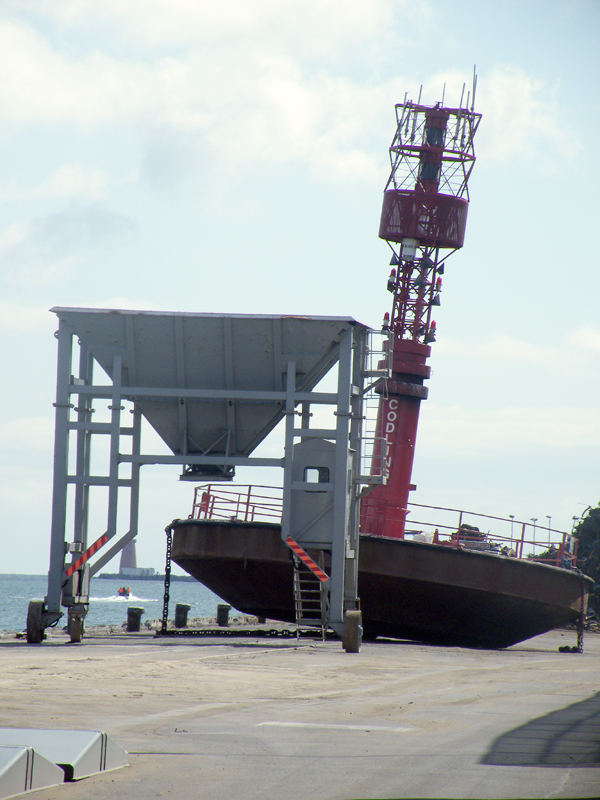
The decommissioned Codling Bank Lanby on the Coal Quay Dublin on 8 August awaiting demolition. Photo: Jehan Ashmore
Second Race Round Arklow Wind Turbines
The second Metmasts Turbine Race takes place around the Arklow wind farm off the east coast of Ireland on Sunday, June 6th. The 34–mile race is expected to take at least six hours to complete in moderate conditions. Last years inaugural fleet, which featured in August Afloat magazine suffered from lack of wind but nevertheless enjoyed Arklow's legendary hospitality supported by sponsor Metmasts.




























